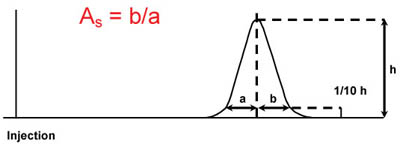System Suitability Calculations
1. Calculation of the number of Theoretical Plates per meter (USP method)
2. Calculation of the number of Theoretical Plates per meter (half-height method)
3. Calculation of Peak Tailing (USP method)
4. Calculation of Peak Asymmetry
5. Calculation of the Height Equivalent to the Theoretical Plate (HETP)
6. Calculation of Reduced Plate Height (h)
7. Calculation of Peak Resolution
1. Calculation of the number of Theoretical Plates per meter (USP method)

Where:
N = Number of theoretical plates
L = Length of column (m)
Ve = elution volume of an unretained non-interactive molecule
h = height of probe peak
wb = width of the peak at the base line
2. Calculation of the number of Theoretical Plates per meter (half-height method)

Where:
N = Number of theoretical plates
L = Length of column (m)
Ve = elution volume of an unretained non-interactive molecule
h = height of probe peak
w1/2 = width of the peak at half peak height
3. Calculation of Peak Tailing (USP method)

Where:
T = tailing factor
b = distance from the point at peak midpoint to the trailing edge (measured at 5 or 10% of peak height)
a = distance from the leading edge of of peak to the midpoint (measured at 5 or 10% of peak height)
4. Calculation of Peak Asymmetry

Where:
As = peak asymmetry
b = distance from the point at peak midpoint to the trailing edge (measured at 5 or 10% of peak height)
a = distance from the leading edge of of peak to the midpoint (measured at 5 or 10% of peak height)
5. Calculation of the Height Equivalent to the Theoretical Plate (HETP)

Where:
H = Height equivalent to the theoretical plate
L = Length of the column bed
N = Number of theoretical plants
6. Calculation of Reduced Plate Height (h)

Where:
h = reduced plate height (sometimes referred to as the number of bead widths)
H = Height equivalent to the theoretical plate
dp = mean particle size
7. Calculation of Peak Resolution

Note: tw1 and tw2 are obtained from the intersection of the tangents with the baseline. For a symmetrical Gaussian peak the tangents are drawn at 0.6 times the peak height.
Where:
Rs = resolution
tR1 = time resolution 1
tR2 = time resolution 2
tW1 = time peak width 1
tW2 = time peak width 2